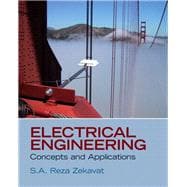
Note: Supplemental materials are not guaranteed with Rental or Used book purchases.
Purchase Benefits
What is included with this book?
S. A. (Reza) Zekavat received his PhD from Colorado State University in 2002. He has co-authored two books, “Multi-Carrier Technologies for Wireless Communications,” published by Kluwer, and “High Dimensional Data Analysis,” published by VDM Verlag; and four book chapters in the areas of adaptive antennas, localization, and spectrum sharing. Zekavat is also editor of the book “Position Location–Theory, Practice and Advances: A Handbook for Engineers and Academics,” which will be published in the near future. He also holds a patent on an active Wireless Remote Positioning System.
Zekavat is the founder of the wireless positioning lab at Michigan Tech. The lab equipment and research has been supported by the National Science Foundation, the Army Research Labs, and National Instruments. Zekavat’s research interests are in wireless communications, positioning systems, software defined radio design, dynamic spectrum allocation methods, Radar theory, blind signal separation and MIMO and beam forming techniques, feature extraction, and neural networking. He is active on the technical program committees for several IEEE international conferences, serving as a committee chair or member. He served on the editorial board of IET Communications between 2008 and 2010, and he is currently with the IET Wireless Sensor System editorial board.
The New copy of this book will include any supplemental materials advertised. Please check the title of the book to determine if it should include any access cards, study guides, lab manuals, CDs, etc.
The Used, Rental and eBook copies of this book are not guaranteed to include any supplemental materials. Typically, only the book itself is included. This is true even if the title states it includes any access cards, study guides, lab manuals, CDs, etc.